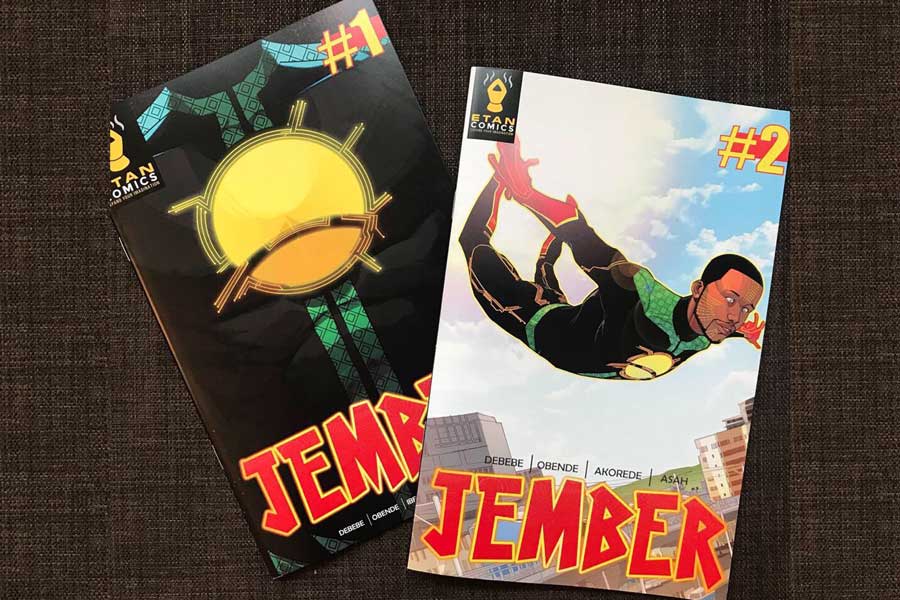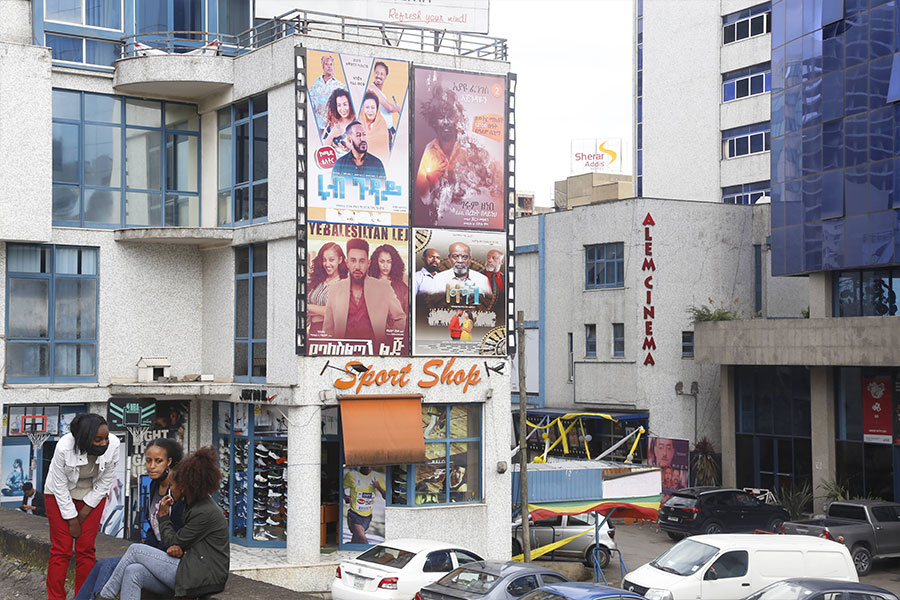
My cinematic journey began in the mid-1980s within the hallowed walls of the National Theatre as a wide-eyed boy. The flickering screen showcased Soviet-produced variety shows (a captivating blend of circus acts, short films and cartoons) all presented in the enchanting language of Russian.
An Amharic translation occasionally provided a lifeline, helping us navigate the intricate plotlines. Yet, the sheer artistry and storytelling prowess captivated our imaginations, even in the absence of subtitles, transporting us to realms beyond our wildest dreams.
The National Theatre provided the perfect backdrop for these cinematic escapades with its acoustically engineered surrounds and spacious hall. The well-spaced aisles, marked by thick, light-blocking curtains, ensured an immersive experience free from distractions.
Even today, as a self-proclaimed cinema enthusiast, I can confidently assert that it remains the finest in Addis Abeba, a testament to the exquisite craftsmanship and timeless design that adorn its every corner.
The Russians, with their rich literary heritage, were undoubtedly masters of storytelling. Their cinematic creations, imbued with the same brilliance that flowed from the pens of literary giants like Tolstoy, Gorky, Dostoyevsky, and Chekhov, were a feast for the senses. These films, primarily geared towards children, were a testament to the Russians' ability to weave tales that captivated audiences of all ages. Perhaps it was the lack of easily accessible Hollywood movies that heightened our appreciation for these Russian masterpieces.
Amidst the throngs of captivated youngsters, I vividly recall the legendary artist Wogayehu Negatu, his iconic Afro hair and woollen scarves adding a touch of mystique to the cinematic experience. He would often observe the shows from the backseats, his presence as enriching as the performances themselves.
Consequently, my thoughts drift to the iconic photo gracing the entrance of the Addis Hilton lobby. Richard Roundtree, the protagonist of "Shaft In Africa," kneels beside a lion, symbolising the film's African setting.
In the movie scene captured in the lobby photo, Wogaeyhu Nigatu plays the role of a photographer, taking shots of Shaft and the Lion. As it progresses, another veteran artist, Debebe Eshetu, emerges as a villain who competes with Shaft. Zenebech Tadesse also plays a scene as a prostitute.
This image captures a pivotal moment in Ethiopian cinema, a proud collaboration between Ethiopian and Hollywood talents. The 1973 film, with its captivating scenes shot in Addis Abeba and Assab port marked a watershed cinematic moment. However, the industry's subsequent decline in the mid-1970s prevented it from fully realising its potential.
By showcasing this iconic photograph, the Hilton Addis paid tribute to Ethiopia's cinematic legacy and its role in hosting a Hollywood blockbuster.
It reminds me of the period when the local cinema scene was near hibernation, its vibrant spirit subdued by the constraints of a tightly controlled political climate. Freedom of expression was severely curtailed, and ideological dictates shaped cinematic content.
The Cold War had cast a long shadow over global affairs, and the Western world found itself locked in a bitter struggle with the left-wing regime. Hollywood movies were perceived as tools of Western soft power, a means of infiltrating the third world with its values and cultural hegemony.
This ideological divide effectively shut down any possibility of collaborations where budding Ethiopian talents shared the screen with Hollywood stars. As a result, Ethiopian cinemas were relegated to showing outdated films, long past their prime even for that era.
It is indeed a bittersweet reminder that half a century later, the country's film industry has yet to reclaim its former glory. The remarkable talents showcased in the film set a high standard that remains to be surpassed by current and future generations of Ethiopian filmmakers.
But all hope was not lost.
Amidst this cultural stagnation, a beacon of hope emerged in the form of the burgeoning video cassette recorder (VCR) technology. Watching movies at home offered a much-needed escape from the limitations imposed on cinema.
Both original and pirated copies of Hollywood and Bollywood films flooded the market, filling the void left by the stunted growth of Ethiopian cinema. While VCRs were still considered luxury items, enterprising individuals stepped in to establish video houses beyond the reach of many households.
These makeshift cinemas provided a gathering place for the youth, who eagerly paid a nominal entrance fee to immerse themselves in the captivating world of foreign films. The public became intimately acquainted with a pantheon of foreign movie stars, emulating their styles and mannerisms and elevating them to idol status.
My experience with video houses was somewhat limited due to my age and the fortunate access to a VCR in my home. While the selection of movies available for rental was relatively restricted, it still provided a welcome alternative to the stale offerings of the local cinemas.
My parents, however, were not particularly fond of the idea of renting movies, often citing concerns about the quality and content of the available options. This resulted in us frequently revisiting the same movies, a practice while repetitive still held a certain charm.
Fast forward to 2023 and I find myself ensconced in the opulent Gold section of the GAST cinema, relishing the complimentary popcorn and chilled Coke served from a folding table with an embedded cooler. The plush leather seats, reminiscent of business-class airline seats, recline a luxurious 180 degrees, offering unparalleled comfort.
Designed to accommodate a mere dozen or so individuals, the Gold class exudes an air of exclusivity and sophistication. This far cry from the austere wooden foldable chairs that characterized my childhood cinema experiences epitomises the remarkable evolution of cinema in Ethiopia.
The place prides itself on screening the latest box office blockbusters simultaneously with their Hollywood releases. When a new franchise hits the screen, the cinema transforms into a bustling hub, attracting record crowds eager to experience the latest cinematic marvels.
I have witnessed instances where movie enthusiasts were turned away due to sold-out screenings, a testament to the cinema's immense popularity.
A few months ago, I was captivated by the release of "Avatar: Way of Water," "Wakanda Forever," the sequel to the groundbreaking "Black Panther" franchise, and "Top Gun: Maverick." The second and third floors of the cinema, where these films were screened, were teeming with teenagers with palpable excitement as they posed for selfies with life-sized replicas of characters set amidst a fantastical backdrop inspired by Pandora's exomoon.
As we delved into the immersive 3D experience of "Avatar: Way of Water," the visual effects transcended the boundaries of the screen, transporting us into the ocean's depths. The fishes seemed to swim right through the audience, creating unprecedented realism.
Compared to these groundbreaking visual marvels, the Soviet films of the 1980s seemed like relics of a bygone era. Cinematic technology has indeed advanced in leaps and bounds over the past decades, and James Cameron's audacious billion-dollar experiment has reaped exponential profits and revolutionised the cinematic experience.
From its humble beginnings as a flickering spectacle on a screen, it has evolved into a captivating art form that transcends boundaries and cultures. It has witnessed a remarkable expedition marked by technological advancements and storytelling innovations.
Indeed, its enchanting and mesmerising effects have reached new heights with the aid of cutting-edge technology and the increasing wit and creativity of professionals.
PUBLISHED ON
Nov 18,2023 [ VOL
24 , NO
1229]


View From Arada | Nov 29,2020

Commentaries | Oct 12,2024

Fortune News | Dec 19,2021

Editorial | Mar 09,2024

My Opinion | May 24,2025

Fortune News | Sep 28,2019

Fortune News | Mar 28,2020

Featured | Sep 10,2021

Dec 22 , 2024 . By TIZITA SHEWAFERAW
Charged with transforming colossal state-owned enterprises into modern and competitiv...

Aug 18 , 2024 . By AKSAH ITALO
Although predictable Yonas Zerihun's job in the ride-hailing service is not immune to...

Jul 28 , 2024 . By TIZITA SHEWAFERAW
Unhabitual, perhaps too many, Samuel Gebreyohannes, 38, used to occasionally enjoy a couple of beers at breakfast. However, he recently swit...

Jul 13 , 2024 . By AKSAH ITALO
Investors who rely on tractors, trucks, and field vehicles for commuting, transporting commodities, and f...

Jun 28 , 2025
Meseret Damtie, the assertive auditor general, has never been shy about naming names...

Jun 21 , 2025
A well-worn adage says, “Budget is not destiny, but it is direction.” Examining t...

Jun 14 , 2025
Yet again, the Horn of Africa is bracing for trouble. A region already frayed by wars...

Jun 7 , 2025
Few promises shine brighter in Addis Abeba than the pledge of a roof for every family...